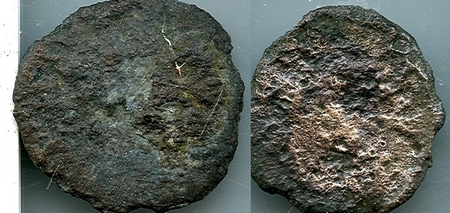 |
 |
 |
 |
 |
 |
 |
 |
 |
 |
 |
 |
 |
 |
 |
 |
 |
 |
 |
 |
 |
 |
 |
 |
 |
 |
 |
 |
 |
 |
|
|
RADIAL BRISTLE
BRUSHES |
|
|
|
This seems to
be a cheap alternative to the famed silver brush. What I am speaking of
can be found at Progresstool.
By far the least expensive that I have found, and excellent service. |
|
 |
|
|
|
|
|
The top portion
of this coin was cleaned with a silver brush, the bottom half was cleaned
with the 6 micron radial wheel ar approximately 10k rpm. In hand, they look
nearly identical in these aspects:
1) Finish is shiny and smooth
2) No loss to patina
3) Light dirt removed
This coin needs a bit more soaking, but as a finishing tool, it looks like
the bristle brush is quite comparable to the silver brush.
The reverse was not touched, and was quite similar to the obverse in dirt,
patina etc, so you can compare the two (forgot to take a before scan of
obverse). I didn't have any almost clean coins to really let the difference
shine, so had to use this one which was close.
|
|
|
|
 |
|
|
|
I only bought
the assortment pack with 80 grit, 400 grit and the 6 micron. The 400 grit
seems useless to me at this stage. The 6 micron seems like a great finishing
tool. The 80 grit I believe could prove quite useful. It removes the patina,
but doesn't seem to damage the metal or the details of the coin at all.
I am going to try the 220 grit as well, that may leave the patina but remove
the dirt. It also seems to get around the details (such as inside lettering)
rather well.
Of course it removes patina, which is normally bad.
The right side was hit at around 7k rpm. This dirt is that hard packed stuff
that even after 2 weeks of soaking, it will just not let go. Even the dddp
barely scratches the dirt, and you can't tell where you worked on it afterwards. |
|
|
|
 |
|
|
|
Here's another
hit with the 80 grit on a heavily encrusted coin that I had slated for electrolysis.
Unfortunately it looks like a complete failure, but that is because the
coin itself was quite beyond help. Pitting is quite evident, some of the
encrustations proved to be metal spurs as well. But, the normal encrustations
came off pretty easily. Perhaps 20 seconds was spent on each side, so this
is a very fast process. |
|
|
|
 |
|
|
|
 |
|
|
|
The black is
something like tar, that will not come off. I have only come across this
substance a couple times, and even lye and electrolysis will not remove
it. I'll find another encrusted coin and try later. |
|
To the next page
Back to the table of experiments |
|
|
|
|
|
|
|
|
|
|
|
|
|
|
|
|
|
|
|
|
|
|
|
|



